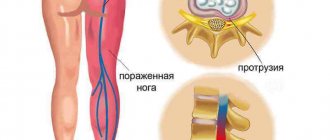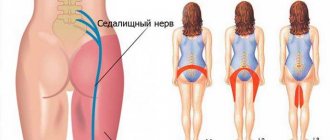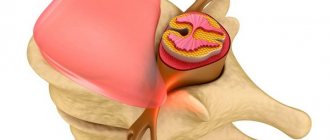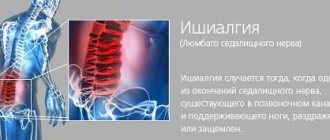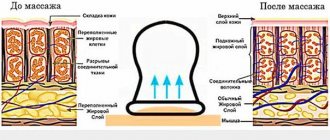Causes of pinched sciatic nerve in pregnant women
Among the most common causes of pinched sciatic nerve during pregnancy are:
- Pressure on the sciatic nerve from the enlarged uterus. Accordingly, as the fetus grows in the uterus, this pressure increases.
- Displacement of intervertebral discs in the lumbar region. This, in turn, can occur due to excessive weight gain, multiple pregnancies, and polyhydramnios.
- Traumatic injuries of the spine in the lumbar region.
In cases where a woman previously had a history of sciatica, but after appropriate treatment its symptoms went away, a relapse may occur during pregnancy. In addition, pinching and inflammation of the sciatic nerve during pregnancy can be a consequence of intervertebral hernia, diabetes mellitus, malignant or benign tumor, osteochondrosis and other diseases. That is why, in order to be able to prevent the occurrence of sciatica or to be prepared for its manifestation, a woman needs to tell her doctor everything about her health.
, the woman will be observed
by a neurologist
together with a gynecologist .
What to do
What should you do when the sciatic nerve is pinched during pregnancy, you ask? Traditional treatment methods consist of the following steps:
- Pain blockades with several drugs in the form of injections will help quickly relieve pain.
- Therapeutic massage will relieve muscle tension, but this procedure should only be carried out in special medical rooms by experienced medical specialists.
- Pain-relieving ointments, suppositories, creams for external use.
- Chondroprotectors.
- Vitamin E.
- Physiotherapeutic procedures.
Symptoms
Pinching of the sciatic nerve during pregnancy does not go away without symptoms and often treatment of the disease is required urgently. Typically, this pathology is manifested by pain, which occurs in various areas of the lower body and has different intensity and frequency of occurrence. The main symptoms of sciatica include:
- Discomfort or pain in the lumbar region or just below it. Further, the pain can move to the sacrum area, and then down to the foot.
- The pain can manifest as shooting and can be observed only at certain points along the path of the sciatic nerve.
- Pain can occur when bending the body, making sudden movements, or turning the body.
- In cases where the compression of the sciatic nerve is too severe, a pregnant woman may experience problems walking. There may also be numbness and loss of sensation in the areas where the nerve is affected.
- When inflammation of the sciatic nerve occurs due to pinching of the sciatic nerve, body temperature may increase.
- Disturbance in the process of urinary excretion, disruption of bowel function.
A pregnant woman should tell her doctor about any of the listed symptoms, and especially if they are observed in combination.
Diagnostic methods
Before starting treatment for this pathology, pinching should be correctly diagnosed. After all, it is dangerous to prescribe treatment based on symptoms alone. This is due to the fact that the symptom of a pinched sciatic nerve may be the result of the presence of other diseases. For example, the same signs will appear in cases of inflammation in the area of the symphysis pubis, or it may be associated with pyelonephritis, myositis and other diseases. Most often, your gynecologist can make an accurate diagnosis.
In rare cases, the doctor may write a referral for consultation with other specialists, a neurologist, nephrologist, urologist, infectious disease specialist, and so on. Sometimes an MRI is necessary. CT scanning is contraindicated during pregnancy. But in most cases, pinching of the sciatic nerve occurs during pregnancy.
Only if there are no contraindications, women can trust the treatment of inflammation of the sciatic nerve during pregnancy to traditional medicine methods. One of the most effective methods of treatment is water procedures using a decoction of juniper and thyme.
You can also use a warm bath with a decoction of elderberry, thyme, motherwort, chamomile, mint, pine buds, hops, tansy and others, which have a calming effect. You can also rub and make compresses from the same herbs.
Pinching of the sciatic nerve during late pregnancy is no less painful. This period is already very difficult for a woman, and besides, she also experiences constant pain.
Pinching of the sciatic nerve during pregnancy is possible in the first two trimesters, but it usually occurs for a number of reasons not related to the woman’s position. At this time they may become:
- injury;
- injury;
- spinal disease;
- hypothermia;
- cold;
- intervertebral hernia;
- arthritis;
- arthrosis;
- constipation
These negative factors cause certain symptoms. They are manifested by displacement of the vertebrae, the development of an inflammatory or infectious process, and severe swelling.
There is unbearable pain in the lower back. It often radiates to nearby areas and also causes numbness in the sacrum and lower extremities. The patient feels as if she has small goosebumps running down her legs.
As a result, significant overloads arise for her, which lead to severe dysfunction of internal organs. Blood vessels, nerve endings, and muscles suffer. The woman has difficulty moving.
The growing belly puts a lot of pressure on the spinal column, causing her condition to constantly worsen. This gradually leads to degeneration of the nerve root, and with it to the development of various associated pathological manifestations.
The main factors that cause nerve compression in pregnant women are the following: weight gain, a shift in the center of gravity and overload of the spinal column, smoothing of lordosis, an increase in pressure on the lumbar region and sacral spine as a result of an increase in the size of the uterus.
In addition, some scientists have suggested the influence of the endocrine system on the occurrence of inflammatory changes in the sciatic nerve. The mechanism of this process is associated with an increase in the elasticity of ligaments under the influence of progesterone.
It is worth noting that compression of nerve fibers does not develop in every pregnant woman, but in women predisposed to this disease. Conditions that provoke the development of pathology include:
- dystrophic and degenerative changes in the spinal column;
- congenital anomalies of the musculoskeletal system;
- pathological condition of the joints of the lower extremities;
- previous operations on the spine and pelvic bones;
- weak muscle frame and poor posture.
In addition, sciatica can develop after hypothermia, the formation of a hernia of the lumbar spine, injury to the lower back, excessive physical activity, sudden movements and other unfavorable conditions.
Often expectant mothers are interested in what to do if the sciatic nerve is pinched during pregnancy. Doctors answer that during this period the main attention is paid to restorative treatment due to the limitations of drug therapy.
Rehabilitation treatment and symptomatic therapy have a positive effect on a woman’s health. Such methods include wearing a bandage, manual therapy and massage, gymnastics and correction of position during sleep, yoga and swimming in the pool.
As medicinal therapy, doctors advise using only local painkillers and anti-inflammatory agents - gels, ointments and rubs. The most common drugs are Voltaren, Emulgel and Dicloberl.
Treatment of pain syndrome using blockades is rarely used, since during pregnancy there is a high probability of the drug entering the bloodstream with subsequent negative effects on the fetus. In the second and third trimester, it is possible to use Movalis or Diclofenac after consultation with an obstetrician.
Gymnastics is an excellent treatment for pain caused by compression of the nerve trunk. Stretching exercises for the lumbar spine should be performed under the supervision of a medical professional.
In exercise therapy, a common complex is used - alternating flexion and extension of the back, yoga exercises, straightening the back, stretching the back of the thigh, etc. Muscle hypertonicity and pain can be eliminated with the help of therapeutic massage and manual therapy.
DETAILS: Treatment of joints with nitrogen: contraindications, indications
The use of various methods of physiotherapy increases the effectiveness of complex treatment. These methods should be used with great caution during pregnancy, and only after consultation with a doctor.
It is possible to use reflexology, laser treatment, magnetic therapy, galvanization and other procedures. Any physical therapy method relieves pain and improves the restoration of nerve fibers.
When doctors are asked how to treat a pinched sciatic nerve during early pregnancy, they note that preference is given to local anti-inflammatory drugs and exercise therapy. Medicines that have an effect on the entire body should be completely excluded to prevent negative effects on the fetus.
How to diagnose pinching during pregnancy?
What to do if you suspect a pinched sciatic nerve during pregnancy? First of all, consult a doctor for diagnosis. To confirm this diagnosis, doctors conduct an external examination, palpation, and also ask the woman to perform several simple motor tests (for example, bend the torso, lie on your back and raise one leg without bending). If a woman feels pain during palpation or with certain movements of the body or legs, then most likely the nerve is pinched.
Also, as part of the diagnosis, standard blood tests are prescribed to assess the woman’s general health and to understand if there is inflammation in the body. Diagnosis of sciatica during pregnancy is complicated by the fact that not all possible and informative methods can be used. For example, during pregnancy, X-rays and tomography are contraindicated, although these diagnostic methods could provide the most complete picture of the development of the disease.
Unconventional methods of treatment
Sciatica can be treated during pregnancy using folk remedies - rubbing or herbal baths.
Compresses
For warming compresses, you can use beeswax, which must first be heated to a plastic state. You need to make an applique out of it on the lower back, secure it on top with cling film and a down scarf. With this compress you can sleep all night.
You can prepare a solution for compresses from chamomile and elderberry. Mix 20 g of herbs, pour 300 ml of boiling water. After half a minute, wrap the herbs in a natural thin cloth and tie a warm scarf to your lower back for 4–6 hours.
Rubbing
Rubbing equal amounts of liquid honey and radish juice will help quickly eliminate pain. The mixture should be rubbed into the inflamed area 3-4 times a day.
Propolis-based cakes are good at relieving inflammation and eliminating pain. Mix 450 g of rye flour with 40 g of propolis or honey, make a flat cake from the dough, secure it on the lower back with plastic wrap and a warm scarf. You can keep it on all day.
Baths
For a bath, you can prepare a decoction of angelica roots - pour 50 g of raw material into 500 ml of boiling water, leave in a closed container for 2 hours. Boil the mixture over low heat for half an hour, pour into the bath. Water procedures should be taken daily, and in case of severe pain - 2 times a day. Duration of therapy is 2 weeks.
For a speedy recovery, a pregnant woman should follow a drinking regime and include in her diet foods that are rich in vitamins A, C, B - greens, bananas, liver, nuts, brown rice.
Pinched sciatic nerve in pregnant women is a common problem that is difficult to treat. To prevent pinching, you need to wear comfortable shoes without heels, do yoga for pregnant women, and avoid drafts and hypothermia. Doctors recommend that women after 16 weeks do not sleep on their backs - it is better to take the fetal position while sleeping.
How to treat?
Any treatment during pregnancy requires special caution. When prescribing certain treatment methods, the doctor must assess the expected benefit to the mother and the possible risk to the fetus. If it is possible to postpone treatment until the postpartum period, then this path is chosen. If the painful condition of a pregnant woman prevents her from moving normally, resting, or she is tormented by unbearable pain, then a course of treatment is necessary. For help in treating sciatica, as well as many other diseases, including during pregnancy, you can contact qualified specialists at the Energo clinic.
Exercise therapy and gymnastics
With the help of physical therapy and special gymnastics, you can fight various neurological diseases, including sciatica. The doctor should prescribe specific types of exercises to perform after assessing the patient’s general condition. Basically, each exercise is aimed at strengthening the back muscles. One of these exercises is arching the back from a starting position on all fours (the so-called “cat”).
Massage
Massage for a pinched sciatic nerve allows you to relieve tension from the muscles, increase their tone, improve the patient’s general condition, improve blood flow and metabolism. It can only be done when there are no acute attacks of pain. This applies not only to pregnancy, but also to the general purpose of massage for pinched sciatic nerves.
Warming up
To eliminate pain, you can use a warming procedure. For this you can use, for example, a belt made of dog hair, pads with buckwheat or flaxseed and other coolants.
Yoga
Calm, relaxing yoga classes help restore emotional balance, relieve muscle tension, and increase muscle tone. After yoga, many pregnant women notice that their general health improves, their mood improves, and their appetite is restored, which, of course, has a positive effect on the development of the fetus.
Manual therapy
Manual therapy helps relieve pain and reduce its attacks. The impact occurs on certain points on the back and legs where the pain is localized.
Compresses
For compresses and rubbing, you can use tinctures of medicinal herbs. This must be done with great caution, following the clear instructions of the doctor, since almost all such tinctures contain alcohol. You also need to remember that in the presence of an inflammatory process in the body or elevated temperature, compresses are contraindicated.
Prenatal bandage
To reduce the load on the spine and maintain it in the correct position, pregnant women are recommended to wear a prenatal bandage. Doctors usually recommend wearing it from the middle of the second trimester. You don't need to wear it all day - about 2-3 hours. It is easier to walk or stand in a brace. It may be uncomfortable to sit and rest in it.
Drug treatment
Drug treatment during pregnancy is rarely used. Most drugs have a number of contraindications in their descriptions, which almost always include pregnancy (especially the 1st and 3rd trimesters). In extreme cases, painkillers, B vitamins, and anti-inflammatory drugs may be prescribed.
Treatment of sciatica in pregnant women
Pinching and inflammation of the neural tube in the mother does not pose a danger to the unborn child. But a woman must start therapy on time to exclude complications during childbirth and postpartum back problems. Treatment is based on the use of safe methods. The woman is prescribed folk remedies, approved medications, special exercises, and manual therapy gives good results.
You should not choose healing methods on your own. In order for the therapy to be successful and without harm to the mother and fetus, a treatment regimen must be prescribed by a doctor. Always after consulting a neurologist, you should visit a gynecologist to further ensure the safety of the prescribed medications and therapies.
Traditional therapy helps relieve the symptoms of the disease and alleviate the condition of a pregnant woman. Warm compresses, rubbing and baths help a lot.
There are several popular and time-tested compresses for pinched sciatic nerves. One of them is nettle. You need to do this compress every time pain occurs.
- Use a head of fresh cabbage.
- Prepare the leaves by separating them from the stalk.
- Leave the leaves in boiling water for 3-5 minutes.
- Take it out and let it cool a little.
- Apply cabbage leaves to the sore spot.
- Wrap yourself in a special film and cover your tailbone with a towel.
- Keep the compress on the affected area for up to 1 hour, until the leaves become cool.
You can prepare a compress with honey and black radish.
- Prepare ½ cup honey and 1 radish.
- Wash the radish, peel and grate.
- Mix the ingredients.
- Apply the resulting mixture to the sore spot.
- Wait 5 minutes.
- Rinse with water.
The compress has a better effect on a steamed body.
It is advisable to use an external product with propolis and beeswax at night. To prepare it you will need
- Melt beeswax in a water bath.
- Prepare propolis oil in the amount of 1 teaspoon per procedure.
- Rub the affected area with propolis oil.
- Apply the heated wax in a thin layer.
- Fix the compress with film and wrap it in a blanket.
- Leave for several hours.
Rubbing helps to activate the work of muscles, nerve endings, and weaken the tone in the lumbar region. Recipes based on bear fat and birch buds are effective against pinching during pregnancy.
Bear fat is heated in a water bath and applied to the sore spot every time pain occurs. The product works better when rubbed rather than simply spread on the body. The fat should be rubbed vigorously to create heat. Carry out procedures for no more than a month.
Prevention measures
It is easier to prevent any disease than to treat it later. Sciatica is no exception. To prevent this disease, women planning pregnancy, like everyone else, should lead an active lifestyle, attend aerobics classes, yoga, go to the pool, and so on several times a week. Strong physical activity, which can negatively affect the condition of the spine, should be avoided. You also need to avoid sudden movements and hypothermia. If, in the process of treating any disease, a doctor prescribes intramuscular injections, they should only be given by a trained specialist. For this purpose, almost every hospital or clinic is equipped with a treatment room. Incorrect insertion of the needle can result in it touching a nerve (which, by the way, is not difficult, because the thickness of the sciatic nerve is approximately equal to a centimeter). Such an injection will cause severe pain, and its consequences can be unpredictable.
How to minimize risk
Doctors advise the following:
- wearing a bandage, especially in late pregnancy, will significantly reduce the load on the back muscles;
- take a special knee-elbow pose several times for 10–15 minutes every day;
- wear comfortable low-heeled shoes;
- perform a complex of gymnastics prescribed by a doctor-instructor;
- completely give up bad habits;
- spend more time in the fresh air;
- take care of the right bed (orthopedic mattress and comfortable pillow);
- follow a daily routine with alternating work and rest.
But, above all, take care of your health. This means paying attention to posture, responding in a timely manner to the first alarming symptoms, providing follow-up treatment and preventing pathologies associated with the spine.
Diagnostic measures
For timely detection of the disease, it is necessary to seek medical help at the first symptoms. Neurologists begin the examination by interviewing and collecting a history of the disease. It is important for the doctor to clarify the nature of the complaints, how long ago they appeared and evaluate the possible causes of sciatica.
After this, a comprehensive neurological examination is carried out to assess the state of the nervous system - the doctor checks sensitivity, gait, reflexes, etc. A woman takes a blood test to rule out infectious diseases.
After formulating a preliminary diagnosis, additional research methods are prescribed. Magnetic resonance imaging allows you to assess the condition of the nerve and tissues near it without harm to the woman and the developing fetus.
Danger to mother and child
In later stages, pinching of the sciatic nerve can lead to premature birth
Pinched nerve endings in the early stages often lead to termination of pregnancy. This is due to sudden contractions of the uterus. In the later stages, it can cause premature birth. In the long term, this condition worsens the mother's health after pregnancy.
In some cases, acute pain that persists until delivery leads to complications during the delivery of the baby. If necrosis of surrounding tissues develops in the affected area, the fetus is in danger due to lack of nutrition.
Among the long-term prospects for a woman’s life:
- spine pathologies;
- immobility or local loss of sensation in the leg;
- disability;
- preservation of involuntary excretion of feces and urine.
To avoid these conditions, it is important to undergo a complete examination before planning a pregnancy. Diagnostic procedures will help to find hidden diseases and cure them before pregnancy. Otherwise, the consequences can be dangerous.
